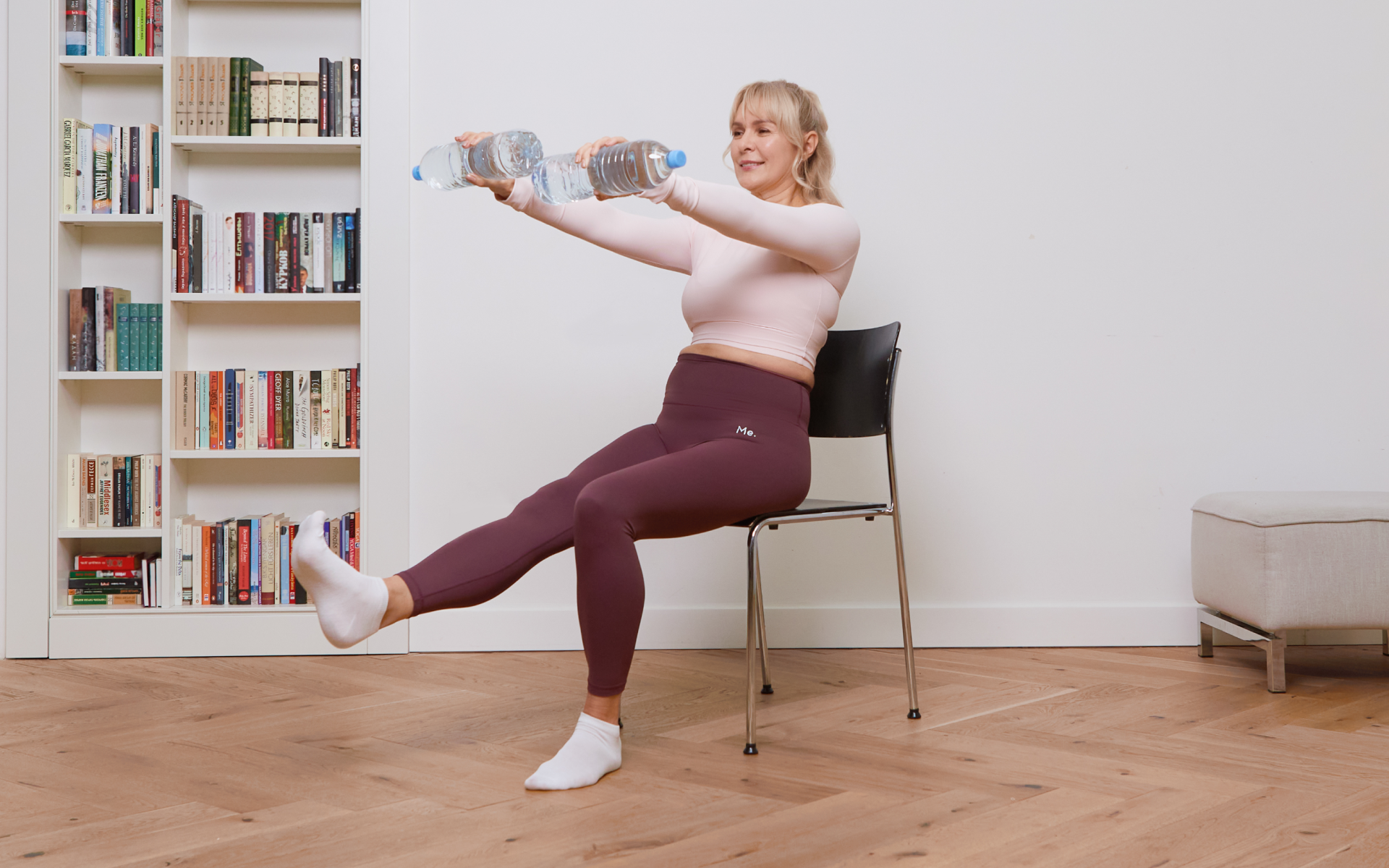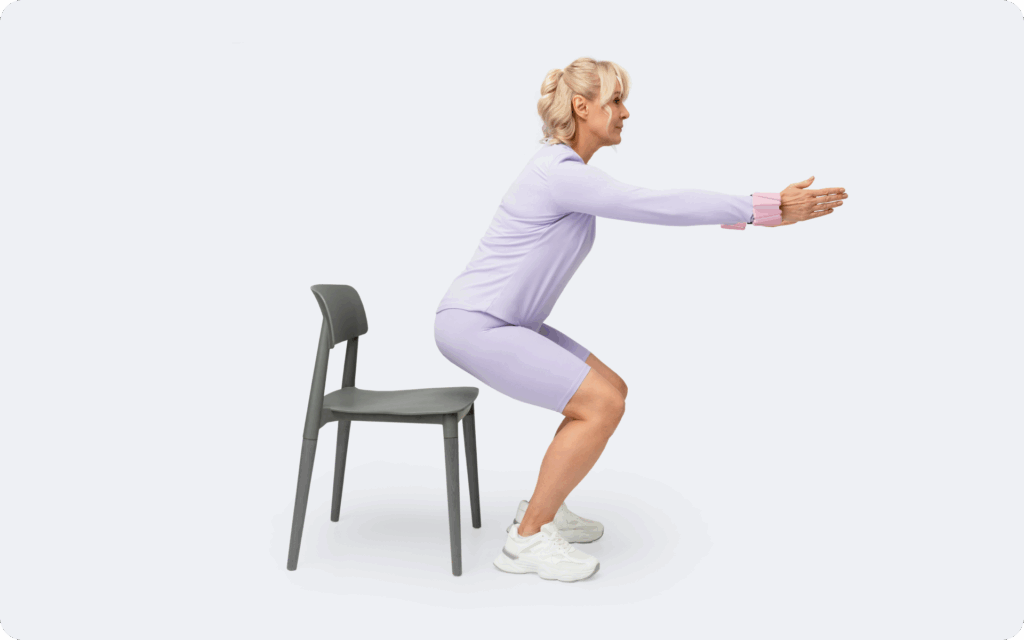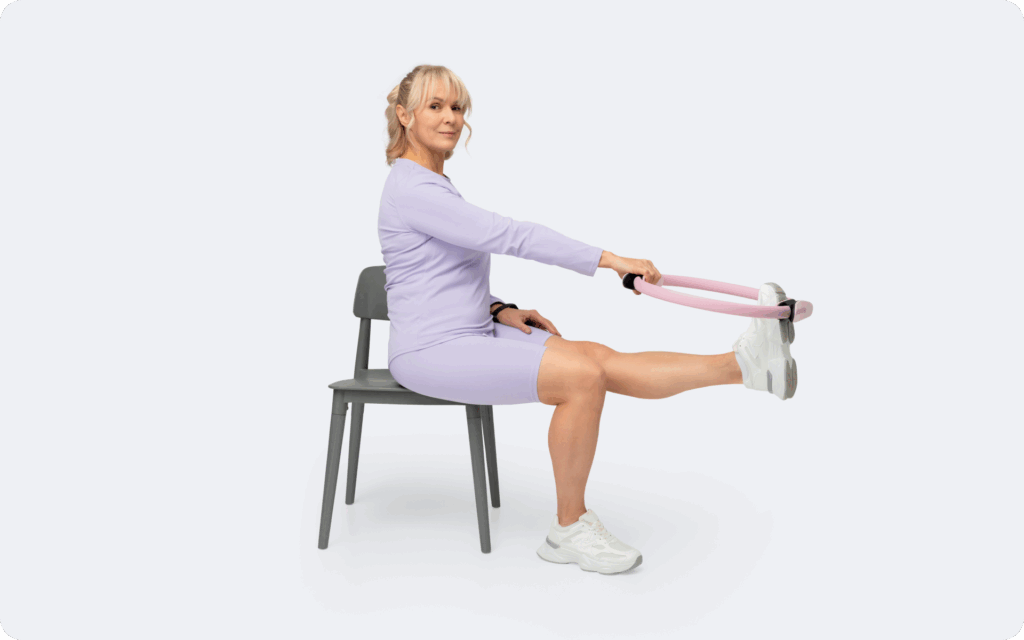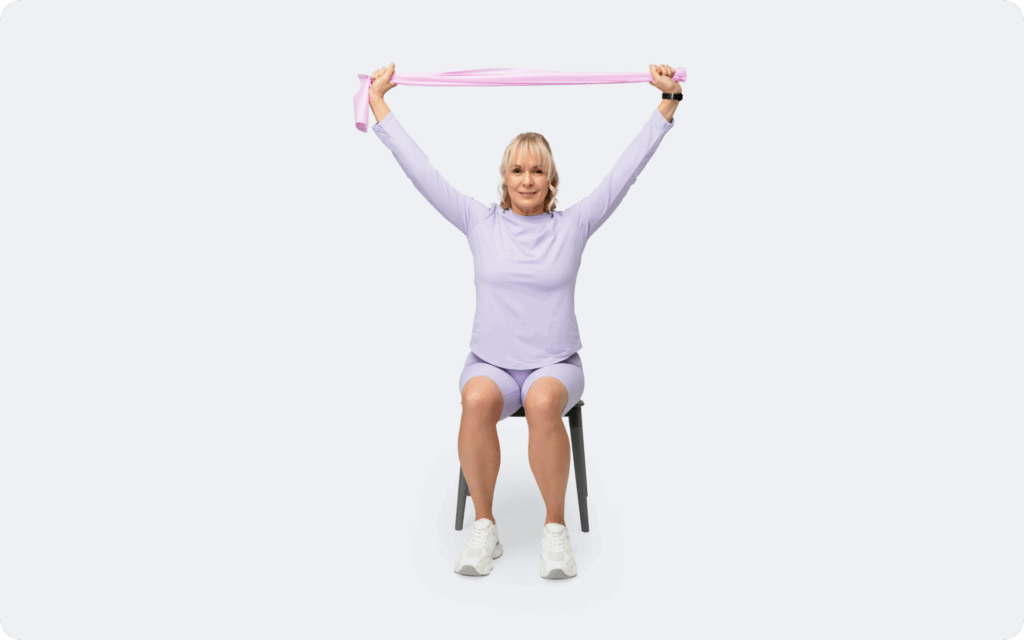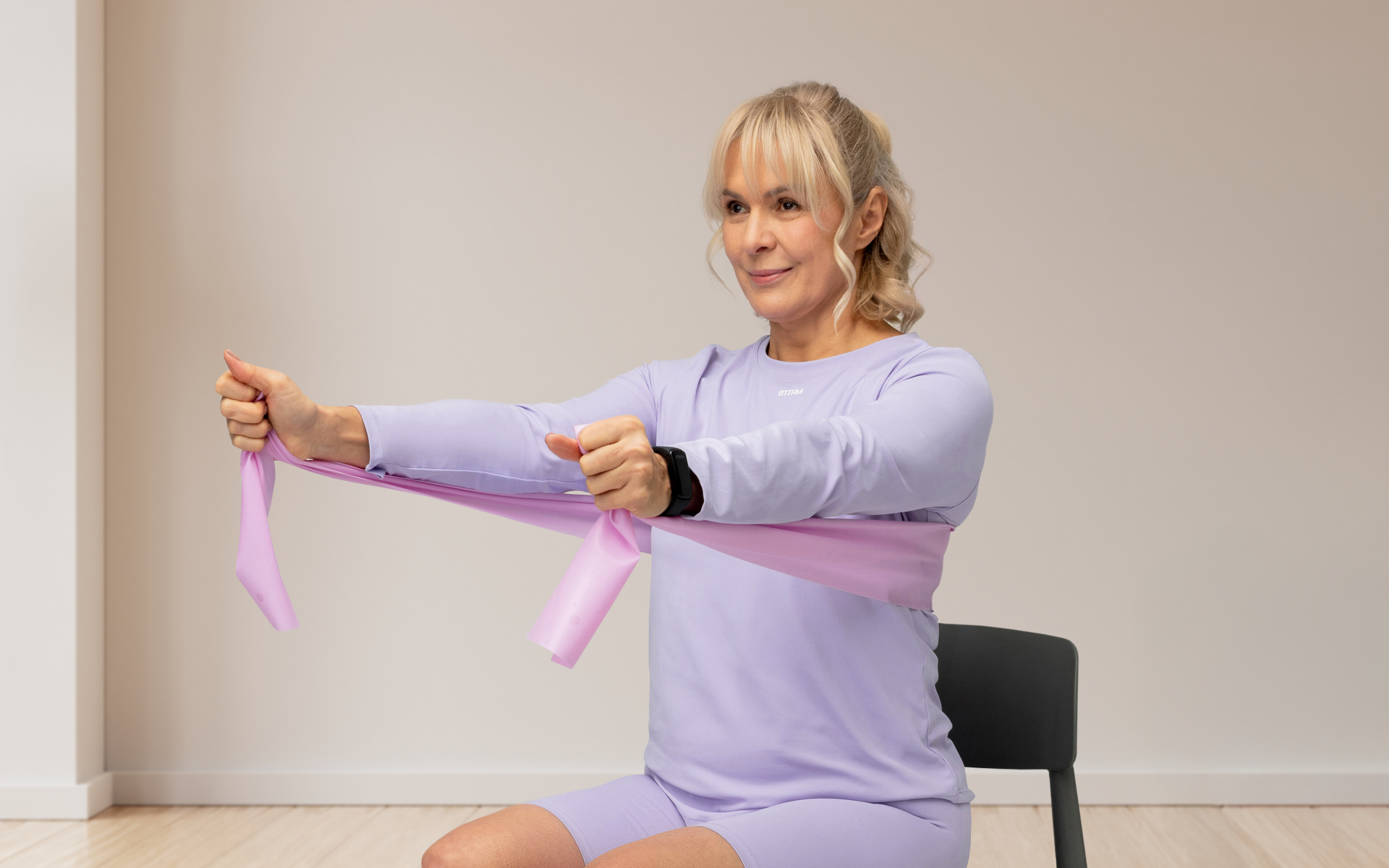Maintaining independence and quality of life as we age is a common goal. A key component of achieving this is staying physically active, but what kind of activity is most effective?
This guide explores functional exercises for seniors, explaining what they are and why they’re beneficial. More importantly, we’ll show you how you can integrate them into your routine to build strength, improve balance, and enhance your daily life. We’ll look at the latest research to provide clear, actionable steps you can take.
What Are Functional Exercises for Seniors?
Functional exercises are movements that are designed to train your body for the activities you perform in everyday life.
Think of them as practice for real-world tasks. Instead of isolating a single muscle, like you might with a bicep curl, functional exercises engage multiple muscle groups and joints simultaneously. This approach mimics how your body naturally moves when you perform tasks such as:
- Getting out of a chair
- Carrying groceries
- Climbing stairs (1)
For adults over 70, these exercises aren’t just about building muscle, they’re about improving your ability to perform activities of daily living (ADLs) with ease and confidence (1).
The core principle is task-specificity. For example, the sit-to-stand exercise directly trains the muscles and movement pattern needed to rise from a sofa or a dining room chair. A 2014 systematic review confirmed that for older adults, this type of training directly improves mobility and reduces disability related to ADLs (2).
Many of these movements can be performed with just your body weight, which makes them excellent functional exercises for seniors at home. As you become stronger, you can introduce light weights.
This progression ensures that functional exercises for seniors with weights are both safe and effective, helping combat age-related muscle loss. Ultimately, these are practical movements with a practical purpose: helping you live a more capable and independent life.
Are Functional Exercises Good for Seniors?
Functional exercises aren’t just good, they’re essential for seniors, particularly those aged 70 and above (1). The evidence supporting their benefits is substantial and growing. The primary advantage is that they directly translate to improved real-world ability, making daily life safer and less strenuous (2).
As we age, we naturally experience a decline in muscle mass, strength, and power. This process, which is known as sarcopenia, can accelerate after the age of 70. It affects maximum strength and more critically, the rate of force development – how quickly you can generate force. This is essential for actions such as catching your balance after a stumble or standing up quickly (3).
A 2022 meta-analysis published in the European Review of Aging and Physical Activity highlighted that power training – moving with intentional speed against a light to moderate load – is often more effective than traditional slow-speed strength training for improving functional tasks such as walking speed and rising from a chair (4).
Reasons why BetterMe is a safe bet: a wide range of calorie-blasting workouts, finger-licking recipes, 24/7 support, challenges that’ll keep you on your best game, and that just scratches the surface! Start using our app and watch the magic happen.
Furthermore, a multi-faceted approach is most effective. Research has consistently shown that programs yielding the best outcomes combine:
- Strength
- Balance
- Mobility
- Power elements
A 2024 systematic review demonstrated that while strength exercise is important, combining it with specific balance exercises is superior for reducing the risk of falling (5). This is why a well-designed functional fitness program goes beyond simple strength and becomes a comprehensive strategy for healthy aging.
Read more: How Standing Hip Exercises for Seniors Can Improve Your Health
What Are the Main Benefits of Functional Exercises for Seniors?
The benefits of a consistent functional exercise routine extend beyond just feeling stronger. They impact almost every aspect of physical well-being, directly enhancing safety, independence, and overall health. Here are the main advantages, supported by scientific evidence.
Improved Strength and Power for Daily Tasks
Functional training strengthens the exact muscles you use for everyday movements. This makes it easier to:
- Carry shopping bags
- Lift grandchildren
- Get in and out of a car
- Perform household chores
By incorporating power-focused movements (e.g. standing up from a chair quickly), you also train your muscles to react faster, which is essential for preventing falls (5).
Enhanced Balance and Reduced Fall Risk
Falls are a major concern for older adults, but they’re not an inevitable part of aging. Functional exercises directly challenge and improve your balance systems. A 2024 review found that balance exercises and multi-component training programs are the most effective interventions for reducing the risk of falling (6).
This training often includes dual-task exercises – performing a cognitive task (such as counting backward) while balancing or walking. This mimics real-world situations, such as navigating a busy pavement while holding a conversation, thereby improving your ability to handle distractions without losing your balance.
Increased Bone Density
Resistance-based functional exercises, particularly when performed with weights, place a healthy stress on your bones. This signals the body to build more bone tissue, which can help slow the progression of osteoporosis and reduce the risk of fractures (7).
Exercises such as supported squats and step-ups are particularly effective for strengthening the bones in your hips and spine.
Greater Mobility and Flexibility
Functional movements take your joints through their full, natural range of motion. This helps maintain and even improve flexibility in your hips, shoulders, and spine. Better mobility means that you can bend down to tie your shoes, reach for items on a high shelf, and turn to look behind you with greater ease and less discomfort (8).
Enhanced Cognitive Function
The link between physical exercise and brain health is well-established (9).
Functional exercises that require coordination, balance, and focus – such as a functional training circuit – stimulate the brain. The dual-task training mentioned earlier is a prime example of how physical and cognitive challenges can be combined to boost brain health and improve executive function.
What Are the Functional Exercises for Seniors to Do Every Day?
While you shouldn’t perform intense strength training every single day, you can and should incorporate gentle movement and specific functional drills into your daily routine. These daily “movement snacks” keep your joints mobile, your muscles active, and your balance systems sharp. They complement your more structured workout days.
Here are three key functional exercises you can do every day. These are considered functional exercises for beginners and are foundational for more advanced work.
1. Sit-to-Stand (Chair Squat)
This is perhaps the single most important functional exercise. It strengthens the legs, glutes, and core, and directly translates to your ability to get up from any seated position.
- Step 1: Setup: Sit on the front edge of a sturdy, stable chair without arms. The ideal chair height is around 45-50 centimeters, as this allows your knees to be at a 90-degree angle. Place your feet flat on the floor, approximately shoulder-width apart.
- Step 2: Execution: Lean your chest slightly forward, keeping your back straight. Press through your heels and stand up completely, squeezing your glutes at the top.
- Step 3: Return: Slowly and with control, reverse the motion. Push your hips back first, as if aiming for the chair, and lower yourself back to the starting position without plopping down.
- Reps: Aim for 10-15 repetitions. If you need support, you can lightly touch a counter or table in front of you.
2. Tandem and Semi-Tandem Stance (Balance Hold)
This exercise directly challenges your balance by narrowing your base of support.
- Step 1: Setup: Stand next to a wall or sturdy countertop for support.
- Step 2: Semi-Tandem: Place the heel of one foot next to the big toe of your other foot. Your feet will be offset.
- Step 3: Hold: Let go of your support if you feel stable. Try to hold this position for 30 seconds. Keep your gaze fixed on a spot in front of you.
- Step 4: Tandem Stance: To make it harder, place the heel of your front foot directly in front of the toes of your back foot, as if walking on a tightrope. Hold for 30 seconds.
- Progression: Once you can hold for 30 seconds without support, try turning your head slowly from side to side to challenge your balance further.
Intense sweat sessions, working weight loss tips, lip-smacking recipes come in one package with the BetterMe: Health Coaching app—all at your fingertips, start transforming your life now!
3. Heel Raises and Toe Raises
These simple movements are crucial for ankle strength and stability, which play a big role in balance and walking.
- Step 1: Setup: Stand tall, holding onto a countertop or the back of a chair for light support.
- Step 2: Heel Raises: Slowly rise up onto the balls of your feet, lifting your heels as high as you can. Hold for a moment at the top, feeling the contraction in your calf muscles.
- Step 3: Lower: Lower your heels back down with control. Perform 15-20 repetitions.
- Step 4: Toe Raises: After your heel raises, shift your weight back onto your heels and lift your toes and the balls of your feet off the floor. You will feel this in the muscles at the front of your shins. Hold for a moment and lower. Perform 15-20 repetitions.
For more ideas on movements you can do from the comfort of your home, you can explore other at-home exercises for the elderly.
Should a 70-Year-Old Exercise Every Day?
The answer is both yes and no. You should aim to move your body every single day. However, you shouldn’t do intense, strenuous exercise every day.
The key is to balance activity with adequate rest and recovery. For adults over 70, recovery is just as important as the exercise itself – it’s during rest that your muscles repair and get stronger.
Here’s a sensible way to think about your weekly activity:
- Daily Movement (Low Intensity)
Activities such as walking, stretching, and the gentle functional drills listed above (such as balance holds and heel raises) are perfect for daily engagement.
A 15-20 minute walk each day is an excellent habit. These activities keep your body mobile and your circulation flowing without causing significant muscle fatigue.
- Structured Exercise (Moderate-to-High Intensity)
Your main strength and balance workouts should be scheduled 2 to 3 times per week on non-consecutive days. For example, you might schedule sessions on Monday, Wednesday, and Friday.
This schedule gives your body at least 48 hours to recover between more demanding workouts, which is essential for building strength and preventing injury.
- Consistency And Adaptability Are Key For Functional Workouts
Listening to your body is crucial. If you feel particularly tired or sore, it’s better to opt for a lighter activity such as a short walk or some gentle stretching rather than pushing through a tough workout. Consistency over a long period is far more important than intensity on any single day.
Read more: 5 Exercises for Seniors: Build Strength, Balance, and Mobility
What Is the Best Exercise Routine for a 70-Year-Old?
The best exercise routine for a 70-year-old is a multi-component program that’s structured, progressive, and tailored to your current fitness level.
A 2024 randomized controlled trial showed that even community-dwelling participants’ exercise programs using a “train-the-trainer” model are highly effective in a group setting (6). This underscores the belief that a good program can be implemented in many settings.
An optimal routine includes elements of strength, power, balance, and mobility. Here’s a sample weekly structure and workout plan that is aligned with the latest research.
Weekly Schedule
- Day 1: Full-Body Strength Workout A
- Day 2: Active Recovery (Walk + Mobility Drills)
- Day 3: Full-Body Strength Workout B
- Day 4: Active Recovery (Walk + Mobility Drills)
- Day 5: Full-Body Strength Workout A/B
- Day 6: Active Recovery (Walk)
- Day 7: Rest
Full-Body Strength Workout A
Perform this routine as a circuit following these guidelines:
- Move from one exercise to the next with minimal rest.
- After completing all exercises, rest for 90-120 seconds.
- Repeat for a total of 2-3 rounds.
- Use a perceived effort (rate of perceived exertion or RPE) of 5-6. *RPE is a self-selected scale of intensity where 1 is the easiest and 10 the maximal effort.
Here are your exercises:
- Sit-to-Stand (Power Focus): 8-10 reps.
- How: From a sturdy chair, stand up as quickly as you safely can. Lower yourself back down slowly (over 3 seconds). The focus here is on the speed of the “up” phase.
- Wall Push-Up: 10-12 reps.
- How: Stand facing a wall, about arm’s length away. Place your hands on the wall, slightly wider than shoulder-width apart. Bend your elbows and lean your body toward the wall, keeping your back straight. Push back to the starting position.
- Seated Row with Resistance Band: 10-12 reps.
- How: Sit tall on the floor or a chair with your legs extended. Loop a resistance band around your feet. Holding the ends of the band, pull your hands toward your torso, squeezing your shoulder blades together. Release slowly.
- Step-Ups: 6-8 reps per leg.
- How: Use a low, sturdy step or the bottom stair. Step up with your right foot, pressing through your heel to bring your left foot up to meet it. Step back down with your right foot, then your left. Alternate which leg you lead with. Hold onto a railing for support.
- Farmer’s Walk: Walk 30-40 feet.
- How: This is an example of functional exercises for seniors with weights. Hold a light weight (a dumbbell, kettlebell, or even a grocery bag with a few cans in it) in each hand. Stand tall with your shoulders back and walk a set distance. This builds grip strength, core stability, and posture.
Full-Body Strength Workout B
This workout integrates balance challenges into the strength movements.
- Supported Split Squat: 8-10 reps per leg.
- How: Stand with a chair or counter to one side for support. Take a step forward with one foot, as if you’re on two separate train tracks. Lower your back knee toward the floor, keeping your front knee aligned over your ankle. Push back up to the start.
- Alternative: Supported Bodyweight Squats
If split squats feel too challenging, use a chair, wall, or countertop for balance and perform a simple bodyweight squat instead. Focus on sitting your hips back, keeping your knees aligned with your toes, and standing up through your heels. This modification reduces balance demands while strengthening your legs and glutes.
- Standing Chest Press with Resistance Band: 10-12 reps.
- How: Anchor a resistance band to a doorknob. Stand facing away from the door and hold the handles at chest height. Step forward to create tension. Press the handles straight out in front of you, then slowly bring them back.
- Single-Leg Stance with Head Turns: Hold for 20-30 seconds per leg.
- How: Stand on one leg, keeping a soft bend in the knee. Hold onto a counter for support if necessary. Once stable, slowly turn your head to look to the left, then to the right. This challenges your vestibular system.
- Hip Hinge (Good Morning): 10-12 reps.
- How: Stand with feet shoulder-width apart, with a slight bend in your knees. Place your hands on your hips. Keeping your back straight, push your hips backward as if trying to touch a wall behind you. Go as far as you can without rounding your back, then squeeze your glutes to return to standing.
Measuring Progress
To know if your program is working, you can use these simple, evidence-based tests every 4-6 weeks.
- 5x Sit-to-Stand Test: Time how long it takes you to stand up and sit down 5 times from a standard chair. A time greater than 12 seconds may indicate an increased risk of falls.
- Timed Up and Go (TUG): From a seated position, time how long it takes to stand up, walk 3 meters (about 10 feet), turn around, walk back, and sit down. A time over 13.5 seconds suggests a higher fall risk.
- Gait Speed: Time how long it takes you to walk 4 meters (about 13 feet) at your normal pace. A speed below 1.0 meters per second is associated with functional decline.
For a deeper dive into building strength, consider reading about functional strength training.
The sit-to-stand (or chair squat) is often considered to be the single most important exercise for elderly people. It strengthens the major muscles in the lower body and core and directly translates to the crucial daily activity of getting up from a chair, toilet, or bed, which is fundamental for maintaining independence. Walking is an excellent low-impact cardiovascular exercise that’s highly beneficial for heart health, circulation, and mood (10). However, it’s not enough on its own. For a complete fitness program, walking should be supplemented with resistance training to build strength and bone density, as well as specific balance and flexibility exercises to prevent falls and maintain mobility. To learn more about the indoor walking workout for seniors, check out our in-depth article on the topic. Resistance training, particularly when it includes a power component, is arguably the most “anti-aging” form of exercise. It directly combats sarcopenia (age-related muscle loss) and dynapenia (age-related power loss), which are two of the primary drivers of physical decline. Building and maintaining muscle helps preserve metabolic health, bone density, and functional independence (11). It’s also been proven to be powerful for enhancing cognitive ability and cognitive function (12). You can tell you’re aging well by your ability to perform daily tasks with ease and confidence. Functional markers are more telling than chronological age. Key indicators include rising from a chair without using your hands, walking at a brisk pace (over 1.0 m/s), easily carrying groceries, and maintaining your balance on uneven surfaces. To lay a solid foundation, you may want to start with a variety of senior strength exercises.Frequently Asked Questions
What is the one exercise you should do as you get older?
Is walking enough exercise?
Which exercise is most anti-aging?
How can you tell if you’re aging well?
The Bottom Line
Investing time in a functional exercise program is one of the most powerful actions you can take to shape your health and independence in the years to come. The goal isn’t to become a world-class athlete, but to become an expert in moving your own body through your own life. By focusing on these practical, evidence-based movements, you’re building a more resilient, capable, and confident version of yourself, one repetition at a time. This structured approach, which includes a blend of functional fitness workouts for over 50 and specific drills for those over 70, is a powerful way to enhance your physical capabilities.
DISCLAIMER:
This article is intended for general informational purposes only and does not serve to address individual circumstances. It is not a substitute for professional advice or help and should not be relied on for making any kind of decision-making. Any action taken as a direct or indirect result of the information in this article is entirely at your own risk and is your sole responsibility.
BetterMe, its content staff, and its medical advisors accept no responsibility for inaccuracies, errors, misstatements, inconsistencies, or omissions and specifically disclaim any liability, loss or risk, personal, professional or otherwise, which may be incurred as a consequence, directly or indirectly, of the use and/or application of any content.
You should always seek the advice of your physician or other qualified health provider with any questions you may have regarding a medical condition or your specific situation. Never disregard professional medical advice or delay seeking it because of BetterMe content. If you suspect or think you may have a medical emergency, call your doctor.
SOURCES:
- Functional fitness – movement for better ageing (2025, ageuk.org.uk)
- Is functional training functional? a systematic review of its effects in community-dwelling older adults (2024, eurapa.biomedcentral.com)
- From molecular to physical function: The aging trajectory (2025, sciencedirect.com)
- Effectiveness of power training compared to strength training in older adults: a systematic review and meta-analysis (2022, eurapa.biomedcentral.com)
- Effectiveness of exercise interventions on fall prevention in ambulatory community-dwelling older adults: a systematic review with narrative synthesis (2023, frontiersin.org)
- FallFitness exercise program provided using the train-the-trainer approach for community-dwelling older adults: a randomized controlled trial (2024, bmcgeriatr.biomedcentral.com)
- Effects of Resistance Exercise on Bone Health (2018, pmc.ncbi.nlm.nih.gov)
- The effect of functional exercise program on physical functioning in older adults aged 60 years or more: A systematic review and meta-analysis of randomized controlled trials (2024, sciencedirect.com)
- The Effects of Exercise for Cognitive Function in Older Adults: A Systematic Review and Meta-Analysis of Randomized Controlled Trials (2023, mdpi.com)
- The multifaceted benefits of walking for healthy aging: from Blue Zones to molecular mechanisms (2023, link.springer.com)
- Aging With Strength: Functional Training to Support Independence and Quality of Life (2025, pmc.ncbi.nlm.nih.gov)
- The effect of resistance training on cognitive function in the older adults: a systematic review of randomized clinical trials (2018, link.springer.com)
